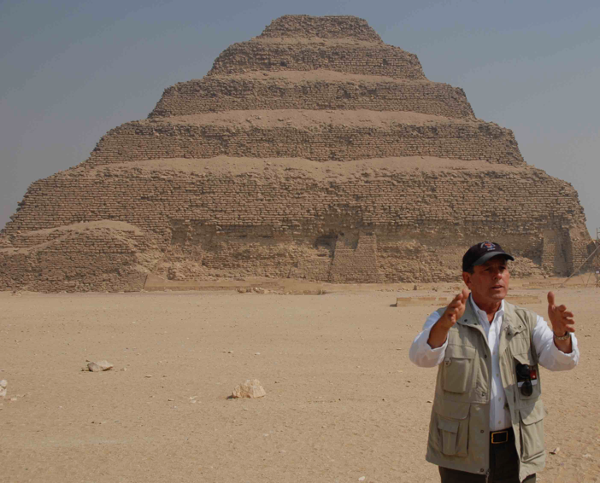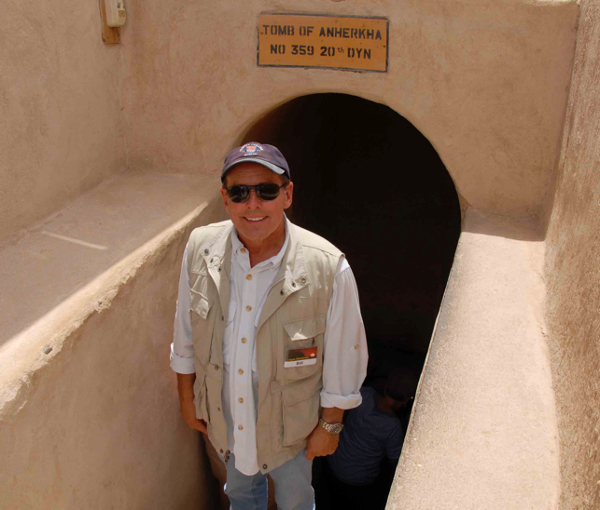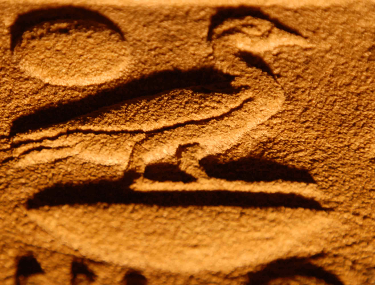Egyptian Myth Busters, Part 1
Photography by Ana Maria Vargas
(Listen to an audio version of the blog post above!)
As most of you know, Logos Bible Study is heading for Egypt—“In the Footsteps of the Patriarchs”—on January 16, 2022, our first post-COVID teaching tour. I love Egypt. It’s a fascinating country with a long and storied history and from a biblical perspective, everything—and I mean everything—in Judaism and Christianity has its antecedents in ancient Egypt. But many people have major misconceptions about Egypt . . . in large part due to Hollywood movies!
This 2-part blog aims to set things straight.
Myth #1
Israelite slaves built the pyramids.
King Zosar’s royal architect, Imhotep, built the “Step” Pyramid as part of a vast funerary complex at Saqqara, Egypt. Not a genuine pyramid, but six mastabas stacked one atop another, the Step Pyramid dates to 2665 B.C.
Dr. C. teaches about the pyramids at the Step Pyramid, Saqqara, Egypt.
The shape of the Step Pyramid suggests the idea of a pyramid, but it’s not an authentic pyramid; one generation later, Huni, the son of Zosar, made the first attempt at a genuine pyramid at Miedum, about 110 kilometers south of today’s Cairo, but he failed, and today Huni’s attempt lies in ruins. Huni’s son, king Sneferu (my favorite Pharaoh J), the grandson of Zosar, began the construction of the first surviving pyramid. He started by building at a 54° angle, but it was too steep. Halfway up, he switched to a 43° degree angle, and he completed the pyramid. It created, however, a “bent” appearance. So, Sneferu rejected it.
Sneferu’s “Bent” Pyramid, Dashur, Egypt.
This is the only pyramid in Egypt that retains most of its smooth limestone casing.
Not to be deterred, Sneferu moved about ½-mile north and constructed the “Red” Pyramid. Built out of pink limestone, the Red Pyramid is the first authentic pyramid with 43° flat sides and three interior chambers, each with corbelled ceilings. The Red Pyramid stands 344-feet high, roughly 35 stories.
Sneferu’s “Red” Pyramid, Dashur, Egypt.
Dr. C. descends down the Red Pyramid’s entrance shaft.
Given the cramped space (it’s only 3-feet high and 4-feet wide, sloping downward at 27° for 720 feet),
you have to go down backward to keep from banging your head!
The Red Pyramid’s corbelled ceiling in the first of three interior chambers.
When most people think of the pyramids in Egypt they think of the three on the Giza Plateau: the great pyramid of Cheops, and its side-by-side mates, the pyramids of Khafre and Menkaura. But in fact, there are at least 118 pyramids in Egypt, and the Step Pyramid, the Bent Pyramid and the Red Pyramid are among the earliest and most interesting.
Pyramids were built during a relatively short period of Egyptian history. The last Egyptian king to be buried in a pyramid seems to have been Ahmose I, founder of the Eighteenth Dynasty (c. 1552 B.C.). The pyramids were most certainly not built by Israelite slaves: when Abraham and Sarah arrived in Egypt, the pyramids were already ancient, and the last pyramid was built before Moses was even born.
Myth #2
Slaves built the tombs in the Valley of the Kings, and then they were killed to prevent others from locating the tombs and looting them.
Building elaborate tombs like those in the Valley of the Kings requires a robust economy and the availability of highly skilled labor. Although the ancient Egyptians had slaves, as virtually every culture in antiquity did, slave labor was not used for building the tombs in the Valley of the Kings.
Recent excavations at Deir el-Medina have unearthed an entire village of craftsmen who were responsible for building most of the 63 tombs found in the Valley of the Kings, including the tomb of King Tut. The excavations have produced a vast quantity of official records, literary texts, private letters and drawings that attest to a highly skilled community of craftsmen who passed their expertise on over many generations from father to son.
The vast residential area of the tomb workers at Deir el-Medina.
Dr. C. emerging from one of the beautiful tombs of the workers at Deir el-Medina.
Myth #3
The Egyptians enslaved the Israelites.
The Israelites came to Egypt during the Middle Kingdom at the time of Joseph, around 1876 B.C. Sometime after Joseph’s death around 1805 B.C., a group of Asiatics called the Hyksos invaded Egypt and controlled it for 100-150 years. It was during this period when foreign invaders controlled Egypt, that “a new king, who did not know about Joseph, came to power in Egypt” (Exodus 1: 8) and enslaved the Israelites. Amonhotep I finally drove out the Hyksos during his reign, 1527-1506 B.C., the beginning of the New Kingdom period. So it was most probably the Hyksos invaders who conquered Egypt and enslaved the Israelites, not the Egyptians.
After Amonhotep I drove out the Hyksos, however, he continued the policy of Israelite enslavement. If we date the Exodus at 1446 B.C., the date internally consistent with the biblical narrative according to 1 Kings 6: 1, then the events recorded in the Bible take place during Egypt’s Eighteenth Dynasty: the Pharaoh of the persecution would have been Thutmose III (1482-1450 B.C.), and his son Amunhotep II (1450-1425 B.C.) would have been the Pharaoh of the Exodus. In addition, Moses must have been born in 1526 B.C., eighty years before the Exodus (see Exodus 7: 7), making Tutmose I (1526-1508) the Pharaoh who orders the drowning of the Hebrew babies. The princess who fishes Moses out of the Nile (Exodus 2: 5-10), then, would have been Princess Hatshepsut, who later becomes Queen Hatshepsut (1504-1482 B.C.), the one who adopts Moses.
The Temple of Hatshepsut in the Valley of the Kings, Egypt.
If we accept 1446 B.C. as the date of the Exodus, then Hatshepsut is the princess who adopts Moses.
Myth #4
Moses was given a Hebrew name by his mother.
We read in Scripture that when Pharaoh’s daughter found the child, “she named him Moses, saying, ‘I drew him out of the water’” (Exodus 2: 10). It is Pharaoh’s daughter, not his mother, who names the boy, and “Moses” is an Egyptian name, not a Hebrew one, meaning, literally, “son of the water.”
In Egyptian hieroglyphs, a wavy line means “water,” and it is pronounced “moo,” while the figure of a duck means “son of,” and it is pronounced, “sa.” Put together, the two words—“moo-sa”—give us “Moses,” “son of the water.”
Here is an example of hieroglyphs taken from the Philae Temple in Aswan, Egypt using both words:
The three elements here are: 1) the sun disk in the upper left corner, representing Ra, the sun god; 2) the duck, which means “son of;” and 3) the bowl, representing the land. Translated, the hieroglyphs mean, “son of Ra, master of the land.”
The four elements here are: 1) the snake, meaning “his majesty;” 2) the triangle, “give;” 3) the wavy lines, “waters;” and the bowl, “the land.” Translated, the hieroglyphs mean, “Give to his majesty, master of the land, the purified waters.”











